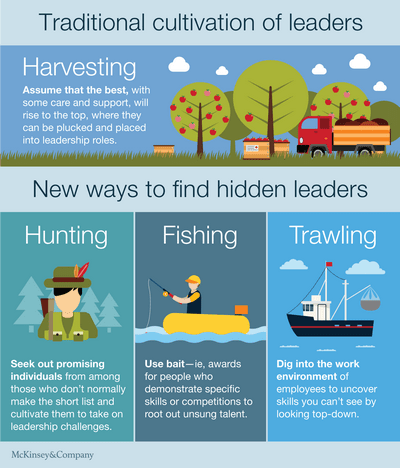To renew themselves, companies have to look for the next generation of leaders. However, it is pretty difficult for them to find the potential business leaders. An article from McKinsey and Company, an international management consulting company, explains that companies have to learn to “hunt, fish and trawl for the best talents”. They have found that companies often only rely on technologies to find the best talent, only outside their organization. However, they tend not to look inside, because some talent remains hidden, not to say that some managers and executives don’t pay attention to them. We will see why some employees are hiding their potential and how companies can find them and help these hidden leaders fulfill their professional development.
Why potential leaders are hiding?
Studies have shown that some employees don’t think about potential development because they decide to follow the standard development path and just want to have the same job until retirement. Some stay behind because they don’t feel like their companies will offer them the possibility to become a leader. However, the new generation coming to work has a relentless curiosity and want to be successful at work. Therefore, the companies have to make sure that they are not missing the skills and knowledge of their collaborators.
These are the main reasons why some employees decide to hide their ambitions:
- The size of the company (it is easier to hide, but also to drown. Personality counts, true, but big companies must look at the performance of their employees, the way they collaborate with others to find potential leaders).
- Bias of any type in selection process (managers often reward people that act like them, that “fit conventional norms”, and they definitely avoid impressive potential).
Companies also tend to believe that the senior leaders are the only ones able to find talented leaders. However, they often miss what individuals have achieved before coming to their company. And if they were looking closer, they would first save money and time, but they would also benefit from it.
How to overcome the obstacles
To find talented business leaders, companies have to use other tools, with new technologies or not. Executives must change their global development management, because this research is actually a management challenge.
Usually, companies are harvesting: they hire new people and they challenge them with huge tasks so they can prove their abilities and to show how they perform. However, this is pretty conventional, and hidden leaders are actually unconventional, and they need more than harvesting. McKinsey has given three techniques:
- Hunting = You have to look for these hidden talents, scan the “non high potential employees” and not be biased. Managers have to look in personnel database, for example, to see why they are hiding (maybe a bad previous experience that stopped them advancing).
- Fishing = Companies have to offer training opportunities so they can be sure they have the possibility to climb the career ladder. But managers must know in advance which attributes are needed for the company.
- Trawling = Observe how people deal with their colleagues in their daily work.
This process is illustrated in the graphic below (belonging to McKinsey)
We can’t change the classical rise to leadership (for now), but companies can evolve, and they can start by looking within the box first. With what they have around them, they can save time, money and gain more valuable benefits.
Author: Anne-Marie

























« Top 5 Job Boards for Disabled People
StartHer launches a job board »




